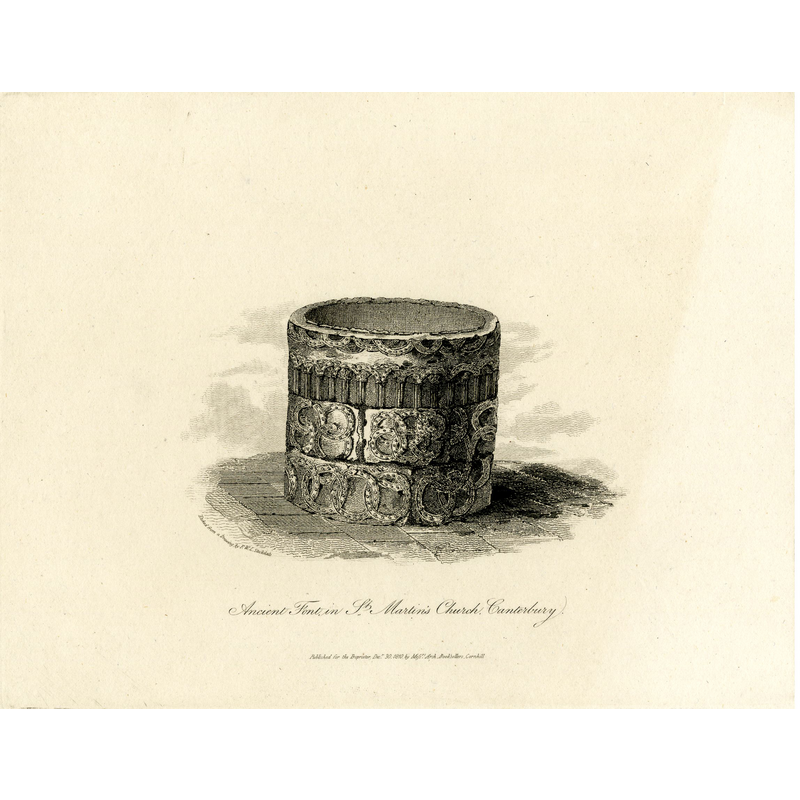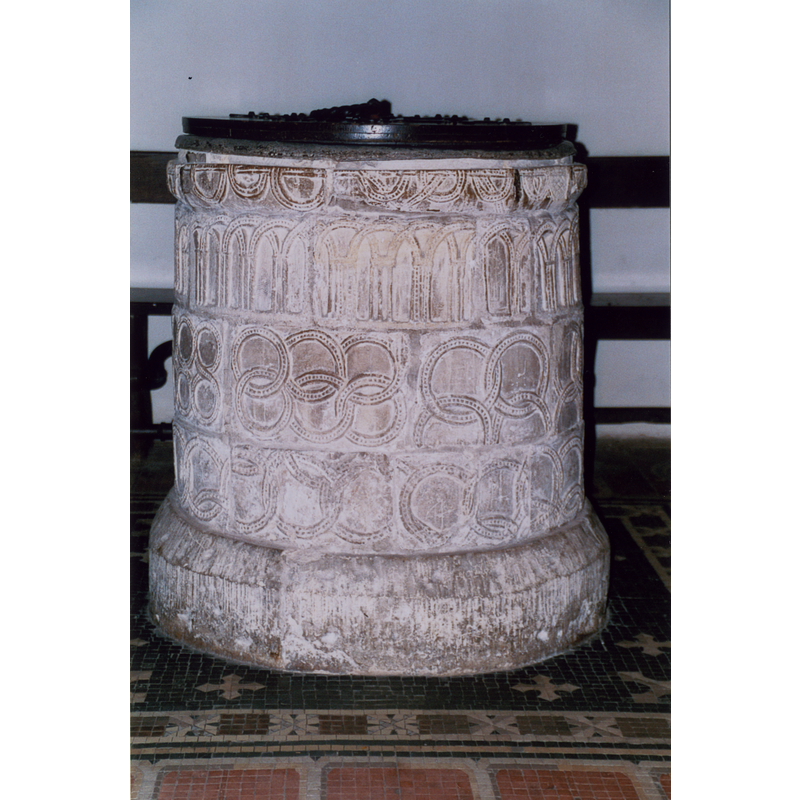Canterbury No. 2

Image copyright © The Trustees of the British Museum, 2012
Image and permission received from the British Museum (email of 12 March 2012)
Results: 6 records
B1R01: design element - motifs - intertwined circular
B2R01: design element - architectural - arcade - blind
view of church interior
view of font
view of font
view of font
Scene Description: ca. 1810 [cf. FontNotes]
Copyright Statement: Image copyright © The Trustees of the British Museum, 2012
Image Source: 1810 etching print "drawn & etched by F.W.L.Stockdale / Published for the proprietor Dec 30 1810 by Messrs Arch, Booksellers, Cornhill", at the British Museum [ref.: AN396815001].
Copyright Instructions: Image and permission received from the British Museum (email of 12 March 2012)
INFORMATION
FontID: 01140CAN
Object Type: Baptismal Font1
Church/Chapel: Parish Church of St. Martin
Church Patron Saints: St. Martin of Tours
Country Name: England
Location: Kent, South East
Font Location in Church: Inside the church, in the W end, S side
Century and Period: 11th - 12th century [altered font?], Medieval / composite
Cognate Fonts: The font at Brabourne, in the same county; also the fonts at Berrick Salome and Lewknor, in Oxfordshire; also the font at Wantisden (Suffolk), perhaps of the same period, and at Potterne (Wiltshire) and the one at Berrick, in East Sussex.
Font Notes:
Click to view
Cylindrical baptismal font, of a shape closely resembling a well-head, and of a type and shape not uncommon in England. The protruding upper rim has semicircles made of dotted tape; below the rim are three registers of ornamentation; the first has criss-crossing arches; the second and the third have linked rings of the same dotted tape. The font is quasi-cylindrical, slightly wider at the base; the lower base is striated and protrudes from the rest. Gough (1792) writes: "The form as well as ornaments of the font in St. Martin's church at Canterbury, pleads strongly in favour of its antiquity. It resembles a tub, as if indeed for immersion". There is a 1810 etching print of this font "drawn & etched by F.W.L.Stockdale / Published for the proprietor Dec 30 1810 by Messrs Arch, Booksellers, Cornhill", at the British Museum [ref.: AN396815001. Department: Prints & Drawings. Registration number: 1870,1008.971. Location: British XIXc Mounted Roy]. Illustrated in a drawing and engraving by W. Deeble, published by W, Clarke in 'The Antiquarian Itinerary' (1815-1818).). Described and illustrated in Simpson (1828), who "had a strong impression that this Font had at some period been taken to pieces and put together again carelessly, which would account for the disunion of the patterns: with this idea we traced off each stone upon separate pieces of paper, and put them together in various ways to ascertain whether any other arrangement than the present would be more correct, but in vain." Simpson counted a total of thirty five stones making up the font; he also discovered that the well lead lining did not reach the bottom of the well and that the hollow space "was partly filled with rubbish"; he mentioned that the drain hole in the lining is unusually large. In Poole (1842), with reference to Britton's Architectutal antiquities, vol. v. In Paley (1844) as Norman. Hussey (1852) writes: "The font here is very curious. It is composed of several pieces of carved stone, but the pattern, though generally alike, does not join correctly; which however more probably may have been caused by the pieces being wrought seprately, perhaps by different individuals, without a previously prepared model or drawing, than that the font should not have been placed here originally". Noted in Glynne (1877). Noted and illustrated in Cross & Hall (1882), who date the font as Saxon but the carving as Norman. Browne (1887) notes that the pattern on this font resembles the buckles on a hog-backed stone in West Kirkby. Described and illustrated in Cox (1905), who writes: "The age of this font has given rise to much discussion and controversy. The intersecting arcade work looks distinctly advanced Norman, but the sculpture of the two lower tiers is just as characteristic of Saxon work. The Norman carved work may have been subsequently added. It is just possible that parts of the font were used at Ethelberfs baptism [i.e., ca. 597 AD], in accordance with the ancient and at one time fairly maintained tradition. Our own theory, long held but never before advanced in print, is that the Saxon font […] in which, or by the side of which, Ethelbert was baptized, and naturally greatly prized, was broken by some accident such as a fall of part of the building, or by some sacrilegious miscreant ; and that then, towards the end of the twelfth century, it was carefully repaired by Norman artificers, and one much broken tier almost entirely renewed or recarved. At all events, there is no other font in the United Kingdom, and so far as is known in all Christendom, constructed of a variety of fragments save that of St. Martin's, Canterbury." Bond (1908) states that the sides of the St Martin's font "consist of no less than twenty-two distinct blocks" and dates some of the ornamentation to the 12th century. Bond (ibid.) denies that it could have the one in which Ethelbert, king of Kent, was baptized, as some have apparently claimed. One such claim appears in Sharp (2000), where it is given a Saxon pedigree: "The unusual Saxon font may have been converted from a 'foot-bath' used in adult baptisms to a taller font for infants by inserting an extra ring of decorated stone." This type of design is, on the contrary, not unusual [cf. for example the Index entry for Ancaster, Lincs.] for Norman fonts of the mid-12th century. That it may have existed as a previous object before, it is a possibility made plausible by the fact that, unlike most fonts of this design, which are monolithic, this one is made of two dozen blocks [cf. Bond, supra]. Tyrrell-Green (1928) admits that perhaps this may not have been the very font Bede referred to in this church and adds that "the present stone font in St. Martin's may be the identical one thus used at the time of St. Augustine's mission"; he adds that this is not a certainty but that "the peculiar way in which this font at St. Martin's is constructed separates it from the Norman fonts which it otherwise resembles, and is so far an argument in favour of its earlier date." As an combined alternative, Tyrrell-Green suggests that perhaps this is the original font and the ornamentation was added later. Listed in Romilly Allen (1888) as one of several "examples of fonts with ornmament of early character". Buck (1950) notes this as an example of an early font re-carved at a later date [NB: the other font Buck mentions is Avebury, which he suggests was a plain Saxon font re-carved by the Normans].
COORDINATES
Church Latitude & Longitude Decimal: 51.277989, 1.093825
Church Latitude & Longitude DMS: 51° 16′ 40.76″ N, 1° 5′ 37.77″ E
UTM: 31U 367051 5682465
MEDIUM AND MEASUREMENTS
Material: stone, limestone
Number of Pieces: thirty five [Simpson, 1828: 5]
Font Shape: tub-shaped (round)
Basin Interior Shape: round
Basin Exterior Shape: round
Drainage Notes: lead lining
Rim Thickness: 14 cm
Diameter (inside rim): 56 cm
Diameter (includes rim): 83 cm
Basin Depth: 35 cm (to the lining)*
Height of Basin Side: 73 cm
Basin Total Height: 95 cm
Font Height (less Plinth): 95 cm
Notes on Measurements: BSI *[NB:The font well may be deeper than the lead lining, but we were not able to access it - Simpson reports the hollow space between the lead lining and the stone bottom but does not give a measruement for that space either]]
LID INFORMATION
Date: modern
Material: wood and metal
Notes: A flat round wooden lid reinforced with metal; has ring handle.
REFERENCES
"Church notes, chiefly in Berks, Wilts, and Oxford, with a few in Somerset and Gloucestershire", 44, Archaeological Journal, 1887, pp. 43-50; 185-193; 291-303; 397-402; p. 146
Antiquarian itinerary, comprising specimens of archictecture, monastic, castellated, and domestic, with other vestiges of antiquity in Great Britain, London: Published for the proprietors by W. Clarke [...], 1815-1818
Allen, J. Romilly, "On the Antiquity of Fonts in Great Britain", XLIV, Journal of the British Archaeological Association, 1888, pp. 164-173; p. 171
Betjeman, John, An American's Guide to English Parish Churches (including the Isle of Man), New York: McDowell, Obolensky, 1958
Bond, Francis, Fonts and Font Covers, London: Waterstone, 1985 c1908
Buck, A.G. Randle, "Some Wiltshire fonts. Part I", LIII, CXCIII (December 1950), The Wiltshire Archaeological and Natural History Magazine, 1950, pp. 458-470; p. 463
Cautley, Henry Munro, Suffolk churches and their treasures, Woodbridge: The Boydell Press, 1982
Clapham, Alfred William, English Romanesque Architecture after the Conquest, Oxford: Clarendon Press, 1934
Cox, John Charles, Canterbury, a historical and topographical account of the city, London: Methuen, 1905
Cox, John Charles, English Church Furniture, New York: E.P. Dutton & Co., 1907
Cross, Francis W., Rambles round Old Canterbury, London; Canterbury: Simpkin, Marshall & Co.; Cross & Jackman and Hal Drury, 1882
Glynne, Steven Richard, Sir, Notes on the churches of Kent, London: John Murray, 1877
Gough, Richard, "Description of the old font in the Church of East Meon, Hampshire, 1789: with some observations on fonts", X, Archaeologia, 1792, pp. 183-209; p. 187, 201
Hussey, Arthur, Notes on the churches in the counties of Kent, Sussex, and Surrey mentioned in Domesday Book and those of more recent date [...], London: John Russell Smith, 1852
Long, E.T., "Dorset church fonts", 44, Proceedings of the Dorset Natural History and Antiquarian Field Club, 1923, pp. 62-76; p. 66
Newman, John, North East and East Kent, Harmondsworth: Penguin Books, 1976
Newman, John, West Kent and the Weald, Harmondsworth: Penguin Books, 1980
Paley, Frederick Apthorp, Illustrations of Baptismal Fonts, London, UK: John van Voorst, 1844
Parker, John Henry, The Ecclesiastical and architectural topography of England: Oxfordshire, Oxford, London: Published under the sanction of the Central Commitee of the Archaeological Institute of Great Britain and Ireland [by] John Henry Parker, 1850
Poole, George Ayliffe, The Appropriate Character of Church Architecture, Leeds; London: T.W. Green; Rivington, Burns, and Houlston and Stoneman, 1842
Pugin, Augustus Northmore Welby, The Present State of Ecclesiastical Architecture in England, London: Charles Dolman, 1843
Ruprich-Robert, V., Architecture normande aux XIe et XIIe siècles en Normandie et en Angleterre, Paris: Libraririe des imprimeries réunies, 1884-1889
Sharp, Mick, The Way and the Light, London: Aurum Press, 2000
Simpson, Francis, A series of ancient baptismal fonts: chronologically arranged, drwan by F. Simpson, Jun., engraved by R. Roberts, London: Septimus Prowett, 1828
Tyrrell-Green, E., Baptismal Fonts Classified and Illustrated, London: Society for Promoting Christian Knowledge: The Macmillan Co., 1928

![the font in its present [July 2000] setting](/static-50478a99ec6f36a15d6234548c59f63da52304e5/compressed/CAN0099900_compressed.png)

